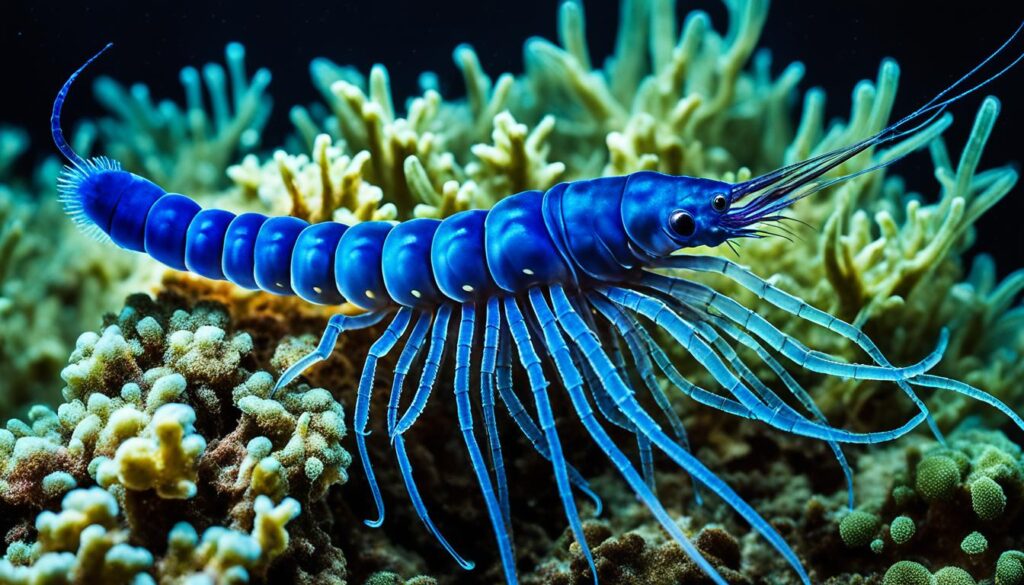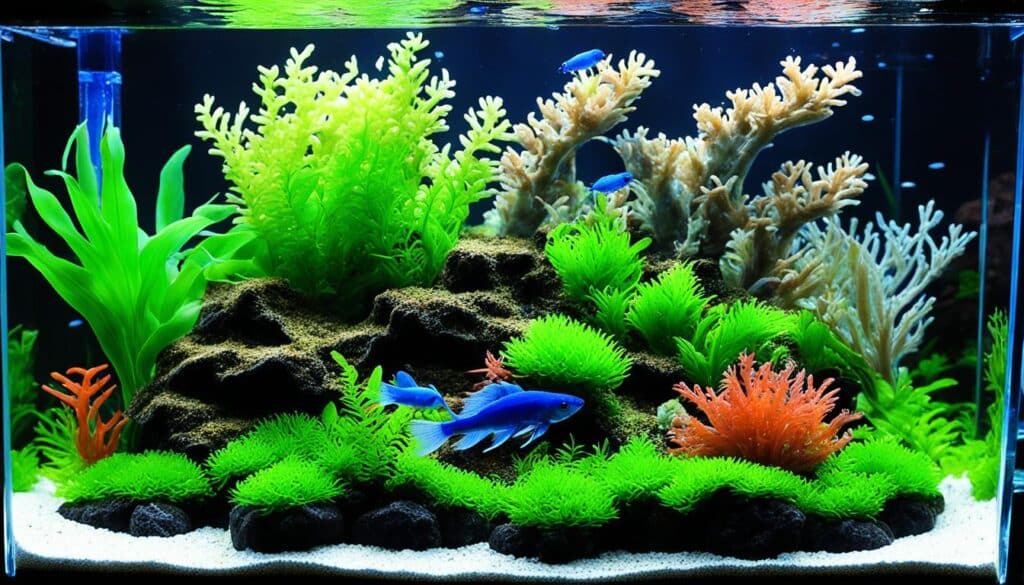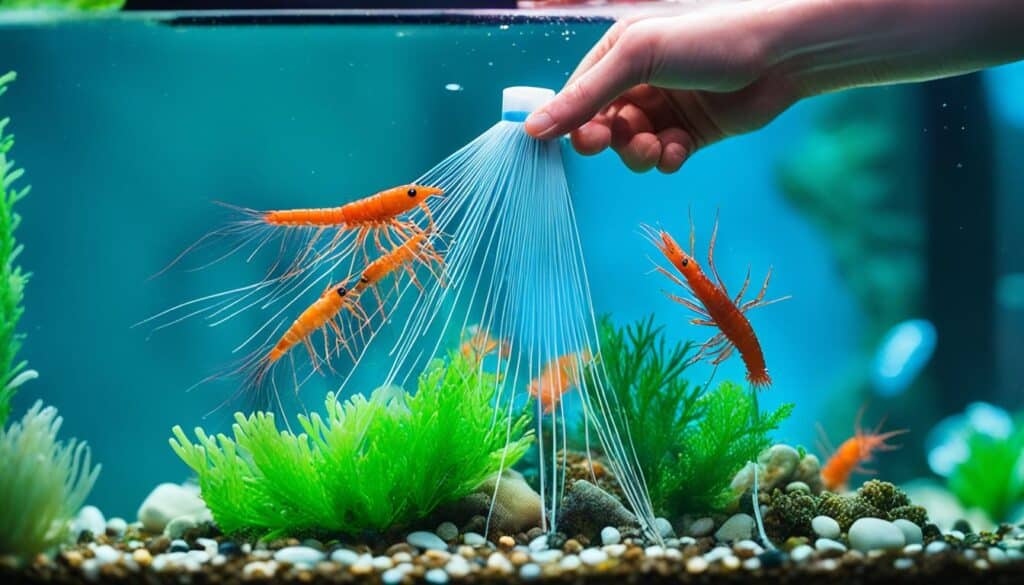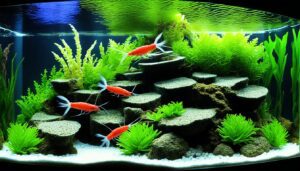Did you know 10 Blue Jelly Shrimp can grow to 1,000 in 6 to 8 months? This happens under the right breeding conditions. These vibrant creatures are easy to care for and bring beauty to freshwater aquariums. As a fan of Blue Jelly shrimp, I’m thrilled to share what I know about these amazing aquarium shrimp. They grow to about 1 inch and are perfect dwarf shrimp. Their lively swimming and blue colors brighten up any tank.
Understanding blue jelly shrimp care is key for a healthy tank, for both new and experienced aquarists. Start with a 5-gallon tank if you’re experienced, or a 10-gallon tank if you’re new. This gives them plenty of space. Care includes weekly tank cleanings and stable water conditions. Keep pH levels between 6.2-8.0 and temperature between 65-85°F.
These shrimp keep the tank clean by eating waste and algae. But, they benefit from a varied diet in captivity. If you’re interested in shrimp breeding, Blue Jelly Shrimp mature by 2-3 months. Female shrimp carry eggs for about 30 days, ensuring a growing population.
Let’s explore the care, tank setup, and lifecycle of Blue Jelly Shrimp. This will help your shrimp thrive in their tank homes.
Blue Jelly Shrimp Species Profile

I’ve always been drawn to the Neocaridina davidi, especially the Blue Jelly variant. These shrimp come from Taiwan. They’re not just pretty but also great for beginners. Their colors vary from ice blue to turquoise with some red spots. It’s a real treat to look at them.
The Blue Jelly Shrimp adapts easily, which is great for those just starting. They do well in many water conditions. Beginners find them easy since they can live in pH between 6.5 and 8. They also tolerate temperatures from 5 to 30 °C.
They’re calm and get along with other peaceful fish and invertebrates. This creates a peaceful tank environment. Fascinatingly, they reproduce quickly, giving birth to 20 to 40 babies every three to four weeks. This is exciting for shrimp keepers.
A tank of 10 liters is the minimum for these shrimp. But I recommend 20 liters for newbies. This extra space helps manage water quality. Good water quality maintains their health and lifespan.
If you’re thinking of starting with shrimp keeping, pick the Blue Jelly Shrimp. They’re easy to take care of and beautiful to watch. Adding them to your tank can bring a lot of joy and vibrant colors.
Coloration and Size of Blue Jelly Shrimp

The Blue Jelly Shrimp comes from selective breeding. It shows how breeding can enhance the beauty of aquarium life. Originating from blue rili shrimps, their color ranges from soft to bold blue. This color can change depending on their diet and the type of ground they live on.
The Result of Selective Breeding
Through selective breeding, the color of dwarf shrimp has been improved. This makes the Blue Jelly Shrimps both beautiful and easy to care for. Not only have they gained a stunning blue color, but they’ve also become stronger. Now they can adapt easily to different environments.
Their Distinct Translucent Blue Hues
Blue Jelly Shrimp sometimes look a bit green, especially after eating green veggies. When set against a dark ground, their blue color looks even more striking. This creates a beautiful contrast in their tank.
Size Differences Among Male and Female Shrimp
Females and males of these shrimp vary in size. Females are larger, reaching up to 1 inch, while males are a bit smaller. This size difference is common in dwarf shrimp types. Let’s look more into their size details:
Shrimp Type |
Size |
Maturity Age |
Optimal Water Parameters |
|---|---|---|---|
Female Blue Jelly Shrimp |
Up to 1 inch |
2-3 months |
pH 7.0-7.6, GH 7-9 |
Male Blue Jelly Shrimp |
1/2 inch – 3/4 inch |
2-3 months |
pH 7.0-7.6, GH 7-9 |
The size difference is important in selective breeding. Larger females tend to have more babies. This leads to stronger and healthier young ones.
Tank Conditions for Blue Jelly Shrimp Thriving

Getting the shrimp tank setup right is crucial for Blue Jelly Shrimp’s health and long life. Let’s dive into creating the perfect home for them. We’ll cover tank size, the benefits of using aquatic plants, and how to keep water conditions ideal.
Choosing the Right Tank Size
A good shrimp tank size is important. For Blue Jelly Shrimp, bigger tanks mean better water stability and a safer living space. The best size is between 20-30 liters. This size gives them plenty of room to swim and helps keep the water clean and stable.
Benefits of Live Plants and Decor
Adding aquatic plants for shrimp has big benefits. Plants like Java Moss and Anubias are not just pretty. They help keep the tank’s environment balanced. These plants absorb harmful toxins and provide oxygen, which is vital for shrimp. They also create hiding places, making shrimp feel safe and at home.
Optimal Water Parameters for Blue Jelly Shrimp Health
The secret to healthy shrimp is the right water parameters. You need to get a balance in various factors:
Parameter |
Ideal Range |
Notes |
|---|---|---|
pH Level |
6.0 – 7.6 |
Depends on specific shrimp species requirements |
Temperature |
18°C – 28°C (64°F – 82°F) |
Neocaridina varieties can tolerate a wider range |
Total Dissolved Solids (TDS) |
150-250 ppm |
Avoid extremes to reduce stress |
General Hardness (GH) |
4-12 |
Proper hardness levels help in shell formation |
Carbonate Hardness (KH) |
4-6 |
Stabilizes pH but keep lower for Caridina |
Regularly checking and adjusting these parameters is key. Doing this makes sure your shrimp do more than just live; they thrive. Whether it’s setting up a new tank or tweaking an existing one, follow these tips for a better shrimp environment.
Diet and Nutrition

It’s vital to know what omnivorous blue jelly shrimp need to eat to stay healthy and colorful in your aquarium. These shrimp are easy to feed, but a balanced diet is key for their well-being and bright colors.
Typical Diet of Omnivorous Shrimp
Blue Jelly Shrimp eat mostly algae and detritus, which makes them great for keeping tanks clean. But in clean or small tanks, where food is scarce, adding to their diet is important. You can feed them high-quality shrimp pellets, blanched veggies like spinach and zucchini, and sometimes, thawed frozen foods.
The Importance of Balanced and Varied Food Selection
It’s important to feed shrimp properly to prevent overeating. Overeating can cause dangerous ammonia levels. Make sure to only feed them what they can eat in a few hours and take out any food they don’t eat. Doing this keeps the water clean and the shrimp healthy.
Changing up their food and ensuring they get a well-rounded diet not only meets their nutritional needs but also promotes natural behavior. This is key for their happiness.
Controlling what you feed your shrimp is about the amount and the quality. Feeding them food free from bad chemicals and full of nutrients makes a big difference in their health. This also makes their blue color more vibrant. Follow these steps for feeding and choosing the right diet to see your shrimp flourish.
Blue Jelly Shrimp and Tank Companions

Adding Blue Jelly Shrimp to a community tank needs careful choice of friends. This ensures a peaceful tank. Below, find the best types of friends that can live with Blue Jelly Shrimp. They help keep your tank happy and healthy.
Picking Peaceful Microfish and Invertebrates
Choosing the right tank mates for Blue Jelly Shrimp is key. You’ll want non-aggressive friends that like the same water. Good picks include Cherry Shrimp, Neon Tetras, and Otocinclus Catfish. They’re peaceful and won’t bother each other.
Species to Avoid in a Community Tank
It’s also vital to know which fish to avoid. Big, mean fish like Cichlids and Betta fish can harm your shrimp. They might eat them or take all the food. So, it’s best to keep them in different tanks.
Below is a chart comparing good and bad choices for your shrimp tank friends:
Compatible Species |
Incompatible Species |
|---|---|
Dwarf Crayfish |
Cichlids |
Thai Micro Crabs |
Goldfish |
Red Racer Snails |
Betta Fish |
Neon Tetras |
Large Gouramis |
Otocinclus Catfish |
Plecos |
Choosing the right tank friends from the list means your Blue Jelly Shrimp will do more than just survive. With these friends, your tank will be a balanced world where everyone gets along.
Breeding Blue Jelly Shrimp in Your Aquarium

To breed blue jelly shrimp, you need the right conditions. This type of shrimp is from the Neocaridina davidi family. People in the breeding community have shared many tips.
Recognizing When Shrimp are Ready to Breed
Female blue jelly shrimp start breeding at about 2-3 months old. You’ll know they’re ready when they carry eggs under their tails. These eggs look like tiny, greenish-gray balls.
Tips for Encouraging a Successful Breeding Environment
Creating a good home for your shrimp is key to breeding success. Here are a few tips:
- Keep water conditions stable: aim for a pH of 6.2 to 8.0 and temperatures between 65-85°F.
- Use a tank that’s at least 5 gallons for enough space.
- Put a pre-filter over the filter intake to keep baby shrimp safe.
- Change 10-20% of the water regularly with treated water for a clean tank.
If you breed blue jelly shrimp with other colors, like Blue Velvet or Bloody Mary, your baby shrimp may change colors. After a few generations, they might look like the wild type again.
Parameter |
Recommended Value |
|---|---|
pH Level |
6.2 – 8.0 |
Temperature |
65 – 85°F |
Water Hardness |
4-12 dGH |
Total Dissolved Solids |
150 – 250 ppm |
Knowing how to breed correctly is crucial. Keep an eye on your tank’s environment. This will ensure your blue jelly shrimp stay healthy and keep their bright color, making your project a success.
Water Quality and Aquatic Health

Keeping the water clean and healthy is vital for Blue Jelly Shrimp to thrive. Shrimp tanks need regular care and close watch. This helps these sensitive creatures live longer and healthier lives.
Regular Maintenance Practices
It’s essential to keep your shrimp tank clean through routine care. You should change 10-15% of the water every week or two. Make sure the new water matches the tank’s current conditions. This keeps the water stable and lowers harmful substances like ammonia and nitrates.
- Monitor the water temperature closely, as the Blue Jelly Shrimp thrives best in temperatures between 18°C and 26°C.
- Avoid the use of products containing copper, as copper is lethal to many invertebrates including our Blue Jelly Shrimp.
- Ensure a good balance of general hardness (GH) and carbonate hardness (KH), with optimal levels around GH 4-8 and KH 4-10.
Water Parameter Monitoring and Adjustments
Get a good water test kit to keep the water quality high. Test regularly to catch any issues early in the pH, nitrate levels, and TDS. Keeping these within the ideal range is crucial.
Parameter |
Optimal Range |
|---|---|
pH |
6.5 – 7.5 |
Temperature |
18 – 22°C |
GH |
6 – 8 |
KH |
6 |
TDS |
150 – 250 |
When adding new shrimp, do it slowly and carefully. Use a drip acclimation method. This method mixes shrimp bag water with tank water, making it easier for them to adjust.
By following these steps, you create a better home for your Blue Jelly Shrimp. Your careful attention to water quality and tank health will make your shrimp tank a success. This dedication is the secret to keeping shrimp healthy and happy.
Purchase and Acclimation Guide
When buying blue jelly shrimp, I always pick suppliers known for their creature’s health and quality. Before I mix them into my aquariums, I make sure they come from trustworthy sources. Aquatic Arts is a great example, offering a live arrival guarantee. Knowing they have a more than 99% success rate in safe shipping, as reported by PNW Bettas, gives me confidence. But if anything goes wrong, their policy is clear. I just need to send a photo of any dead fish or shrimp within 2 hours of getting them. Then, I can count on a quick resolution.
The process of getting shrimp used to a new tank is key to their survival. I start by getting the tank ready ahead of time, usually 3 to 7 days before they come. This prepping helps bring out their best colors and health. After my blue jelly shrimp get here, I use the drip method for acclimation. This means letting water drop into their container very slowly at 2 to 3 drops per second. This goes on for about 1.5 to 2.5 hours, helping them get used to their new home gently.
I choose fast shipping options like UPS Next Day Air or USPS Priority to get them quickly and safely. Depending on the weather, I make use of heat or cold packs provided by the shipper at no extra cost. Once the shrimp are in their new tank, I turn off the tank light for the first 24 hours. This helps them settle in with less stress. Even though I might want to feed them, I wait a full day before doing so. This allows them time to adjust to their new surroundings. By paying attention to these steps, my blue jelly shrimp are well-set to prosper in their new underwater home.








